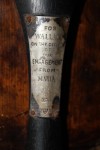 The violin believed to be the one played by bandmaster Wallace Hartley as Titanic sank the night of April 14th, 1912, has sold at auction for a record £900,000 ($1,454,000) hammer price, £1.1 million ($1,778,000) including buyer’s premium and taxes. The previous record price for Titanic memorabilia was just set in May of 2011 when the 33-foot-long plan of the ship made for the British Board of Trade’s inquiry into the disaster sold for £220,000 ($363,000).
The violin believed to be the one played by bandmaster Wallace Hartley as Titanic sank the night of April 14th, 1912, has sold at auction for a record £900,000 ($1,454,000) hammer price, £1.1 million ($1,778,000) including buyer’s premium and taxes. The previous record price for Titanic memorabilia was just set in May of 2011 when the 33-foot-long plan of the ship made for the British Board of Trade’s inquiry into the disaster sold for £220,000 ($363,000).
The buyer is a British collector of Titanic artifacts who has of course chosen to remain anonymous. It took less than two minutes for the bids to go from £50 — an artificially low opening point that was a gift from auctioneer Alan Aldridge to two of his friends who just wanted to get a bid in — to £100,000. Within 10 minutes the final two buyers standing, both anonymous phone bidders, had battled it out to the rousing £900,000 finale.
There was a great deal of interest in this piece, not all of it approving. The circumstances of its survival and rediscovery read more like fiction than reality, so much so that an elaborate hoax seems at least as possible as it being Hartley’s violin.
 It was found in a leather luggage case monogrammed “W. H. H.” (Wallace Henry Hartley) which also held a silver cigarette case, a signet ring and a letter written by the violin teacher who had given the objects to the current owner’s mother. On the tail piece of the violin is a silver plate inscribed “For Wallace on the occasion of our engagement from Maria.” Wallace Hartley’s fiancé Maria Robinson gave him a violin when they got engaged in 1910, and he brought it on the Titanic.
It was found in a leather luggage case monogrammed “W. H. H.” (Wallace Henry Hartley) which also held a silver cigarette case, a signet ring and a letter written by the violin teacher who had given the objects to the current owner’s mother. On the tail piece of the violin is a silver plate inscribed “For Wallace on the occasion of our engagement from Maria.” Wallace Hartley’s fiancé Maria Robinson gave him a violin when they got engaged in 1910, and he brought it on the Titanic.
The violin teacher’s letter told the remarkable story that Maria Robinson’s sister Margaret had given the violin to the local Salvation Army after Maria’s death in 1939. Margaret told the Bridlington Salvation Army leader, Major Renwick, about the instrument’s history and Renwick gave it to one of their members who was a violin teacher. That teacher gave it to one of his students and that years later student’s son found in the attic.
 The owner took the violin to auction house Henry Aldridge & Son to have it authenticated in 2006. That was no easy task. The very notion that the violin could have survived intact strapped to the chest of the dead musician while his body floated in the frigid north Atlantic for 10 days is a fanciful one, to put it mildly. Aldridge spent seven years analyzing the instrument, enlisting experts to determine if it was a forgery, a pastiche of period elements like a 1910 silver plate cobbled together and dunked in sea water to make it seem legit.
The owner took the violin to auction house Henry Aldridge & Son to have it authenticated in 2006. That was no easy task. The very notion that the violin could have survived intact strapped to the chest of the dead musician while his body floated in the frigid north Atlantic for 10 days is a fanciful one, to put it mildly. Aldridge spent seven years analyzing the instrument, enlisting experts to determine if it was a forgery, a pastiche of period elements like a 1910 silver plate cobbled together and dunked in sea water to make it seem legit.
Henry Aldridge & Son felt they’d sufficiently established its authenticity to announce the find in March of this year. In May, one more test was performed: a CT scan at BMI Ridgeway Hospital in Wiltshire.
Astrid Little, Imaging Manager at the Wroughton hospital explains why a CT scan helped in the authentication process: “A 3D image of the violin was created from the CT scan, meaning the violin could be examined from the inside. The scan revealed that the original wood was cracked and showed signs of possible restoration. The fine detail of the scan meant the auctioneers could examine the construction, interior and the glue holding the instrument together.”
[youtube=http://youtu.be/BMUyrpIsE0A&w=430]
After it was released from the hospital, the violin went on tour, stopping at two Titanic museums in the United States, Branson and Pigeon Forge, where 315,000 people viewed it over the course of three months. After that, it went back across the ocean to the Titanic Belfast, the exceptional museum overlooking historic slipways where Titanic and Olympic were built.
There are still many doubts as to how any wooden instrument could have survived intact the sinking of the Titanic and subsequent week and a half in the water. Still, somebody was willing to bet $1.78 million on the chance of it being the real deal.